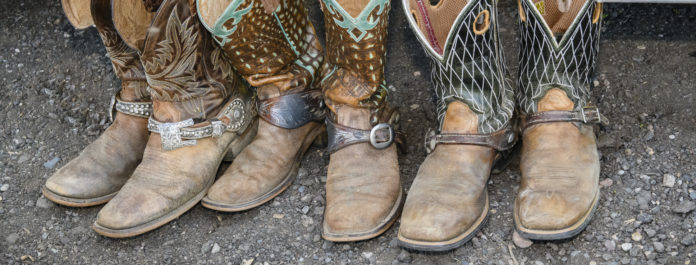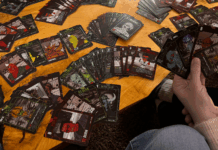EVERYTHING YOU WANTED TO KNOW ABOUT RODEOS, BUT WERE AFRAID TO ASK
Photos by Bob Hosker
Today’s professional rodeo holds a distinct position in the world of modern sports having come directly from a working ranch lifestyle. Early rodeo began as the everyday chores of working ranches on the great plains of the American West. These chores would eventually evolve into the unique rodeo events that we enjoy today.
Rodeo is also unique in that it is a sport made up of several different events, each with their own style of competition, rules, and rewards. While there are many events that are specific to different regions of the U.S. and the world, seven are recognized as standard events in most professional rodeos.
The seven main events are (in the standard order of competition):
1. Bareback bronc riding
2. Steer wrestling
3. Team roping
4. Saddle bronc riding
5. Tie-down roping
6. Cowgirl’s barrel racing
7. Bull riding
These seven events can be broken down into two categories, the rough stock/judged events (bareback, saddle bwronc, and bull riding) and the timed events (steer wrestling, team roping, calf roping, and cowgirl’s barrel racing).
The Events – Rough Stock/Judged
Bareback Bronc Riding
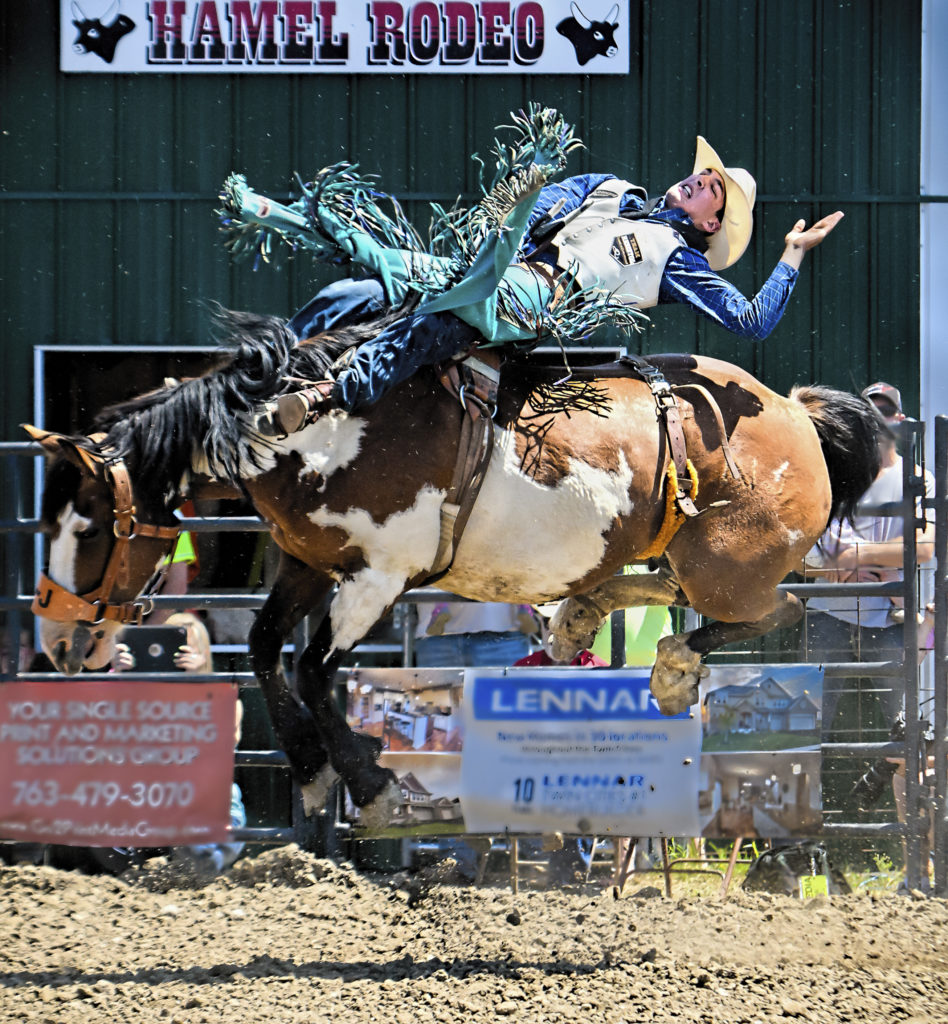
In this event, the horse has no saddle or reins attached. The only thing for the rider to hang onto is a “handle” (similar to a suitcase handle) attached to a strap, which is fitted around the horse’s body. The rider holds on with one hand and the other hand is free. If the rider touches himself or the horse with his free hand, he is disqualified. On the first jump out of the chute, the rider must “mark the horse out.” This means he must have the heels of his boots in contact with the horse above the point of the shoulders before the horse’s front legs hit the ground. Failure to mark the horse results in a disqualification, as does failing to stay on the bronc for eight seconds.
Saddle Bronc Riding
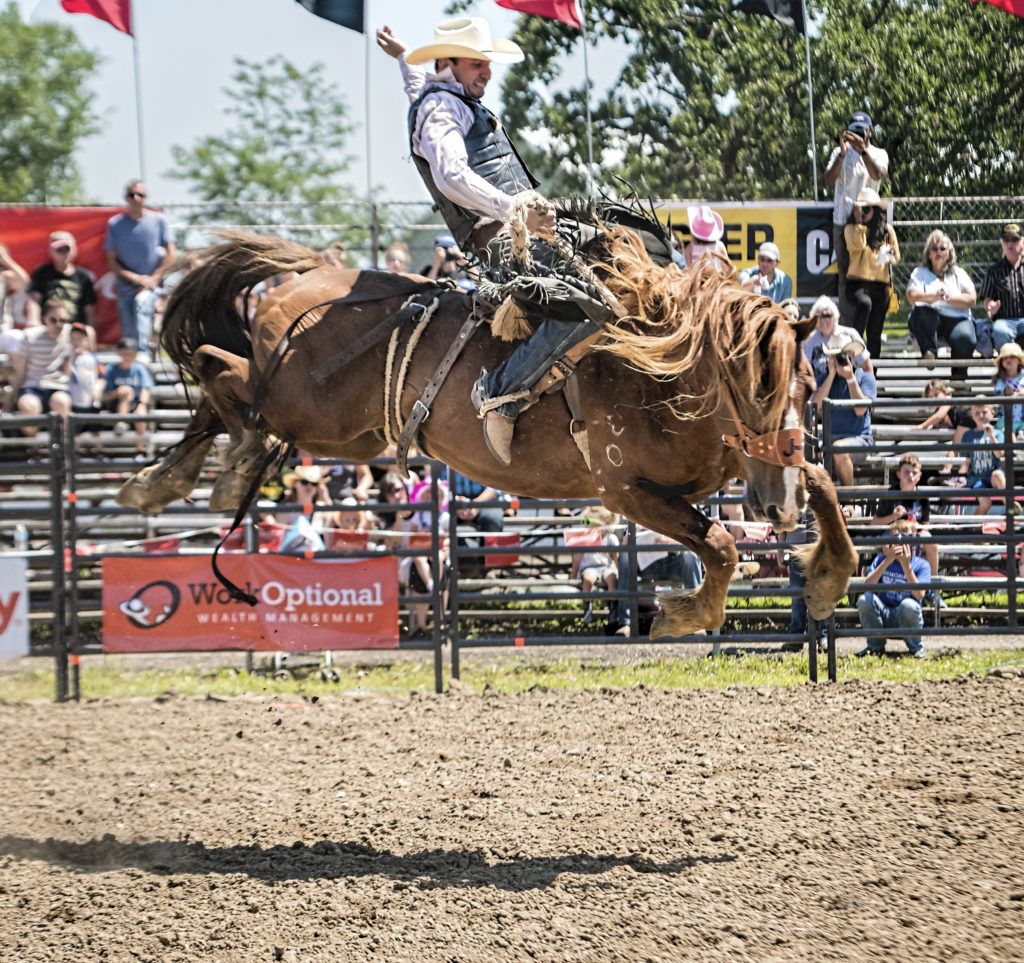
Often referred to as the “classic event of rodeo,” saddle bronc riding began back in the days when breaking horses was a necessity. Saddle broncs are usually several hundred pounds heavier than bareback horses and generally buck in a slower manner. The saddle bronc rider sits on a specialized saddle with free-swinging stirrups and no horn. The rider grips a simple rein braided from cotton or polyester and attached to a leather halter worn by the horse. While striving to keep his toes turned outward, the rider “spurs” from the points of the horse’s shoulders to the back of the saddle. To score well, the rider must maintain that action throughout the eight-second ride. Every move the bronc rider makes must be synchronized with the movement of the animal. The cowboy’s objective is a fluid ride, somewhat in contrast to the wilder and less-controlled rides of bareback riders.
Like the bareback rider, the saddle bronc rider must mark out his horse, prevent his free hand from touching anything, and stay on the horse for eight seconds, or he will be disqualified.
Bull Riding
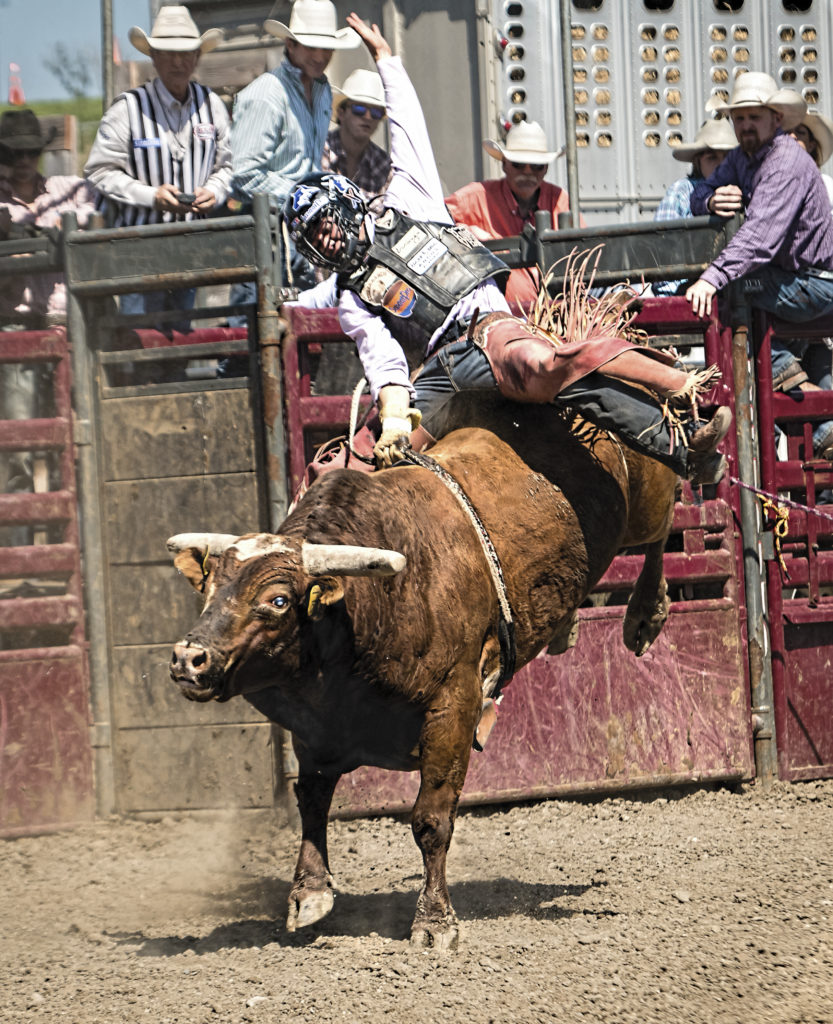
Known as the most dangerous sport in Rodeo and possibly sports in general, bull riders, who might not weigh more than 120 pounds, attempt to stay on top of a bucking bull that weighs almost 2000 pounds, for eight long seconds. A flat braided rope is placed around the bull’s chest, just behind the front legs and over its back. One end of the bull rope, called the tail, is threaded through a loop on the other end and tightened around the bull. The rider then wraps the tail around his hand, sometimes weaving it through his fingers to further secure his grip. Like bareback and saddle bronc riders, the bull rider may use only one hand to stay aboard during the eight second ride. If he touches the bull or himself with his free hand, he is disqualified. But unlike the other rough stock contestants, bull riders are not required to mark out their animals. And while spurring (like the saddle bronc riders do) can add to the cowboy’s score, riders are commonly judged solely on their ability to stay aboard the twisting, bucking mass of muscle.
The Events – Timed
Steer Wrestling
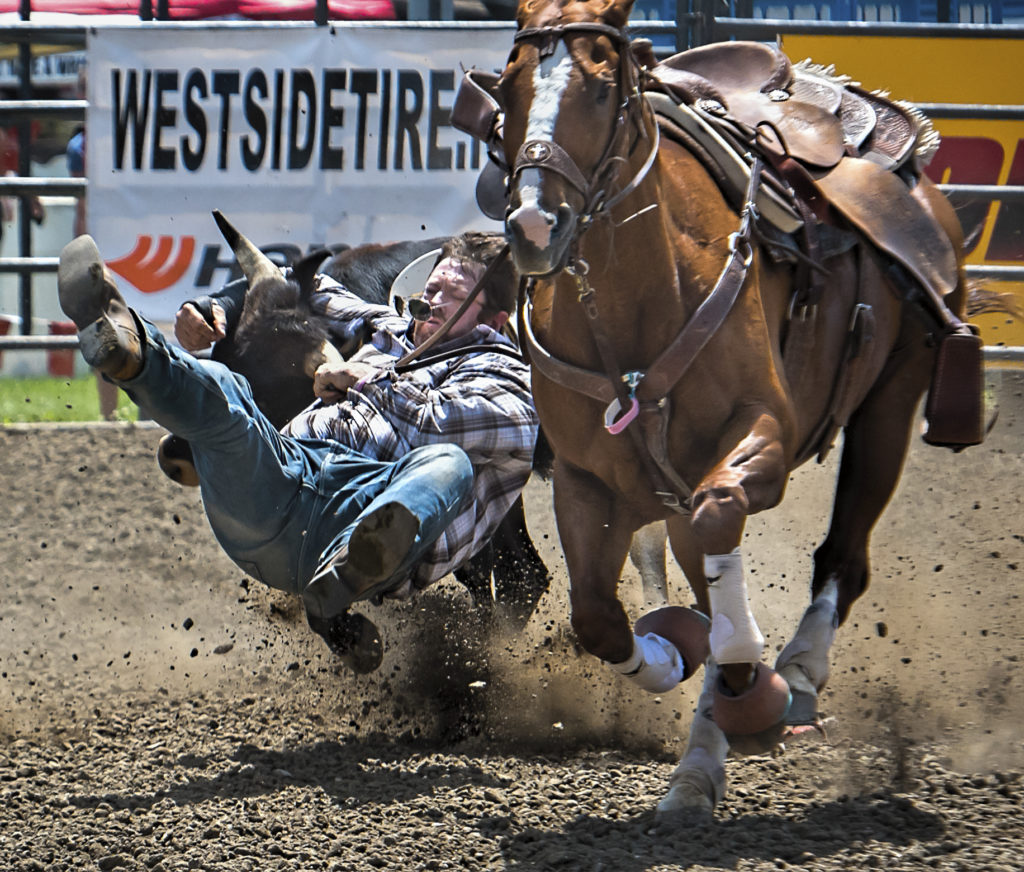
This is a team event requiring a wrestler to leap from a galloping horse onto a horned steer at a dead run. The steer is released from the chute first, and a “hazer” rides parallel to the animal to ensure it runs in a straight line. After the steer has a head start, the steer wrestler takes off after it and attempts to catch up to it. The wrestler’s horse is running flat out, and the cowboy has to lean over the side of the horse and grab the horns of the running steer. He then leaves his horse and plants his heels into the dirt to slow the steer and himself. He takes one hand off the horns, reaches down and grabs the nose of the steer, pulling the steer off balance and ultimately “throwing” the steer to the ground. Once the steer is on its side with all four legs pointed in the same direction, an official waves a flag marking the official end and a time is taken.
If the wrestler takes off too early, a ten second penalty is assessed.
Team Roping
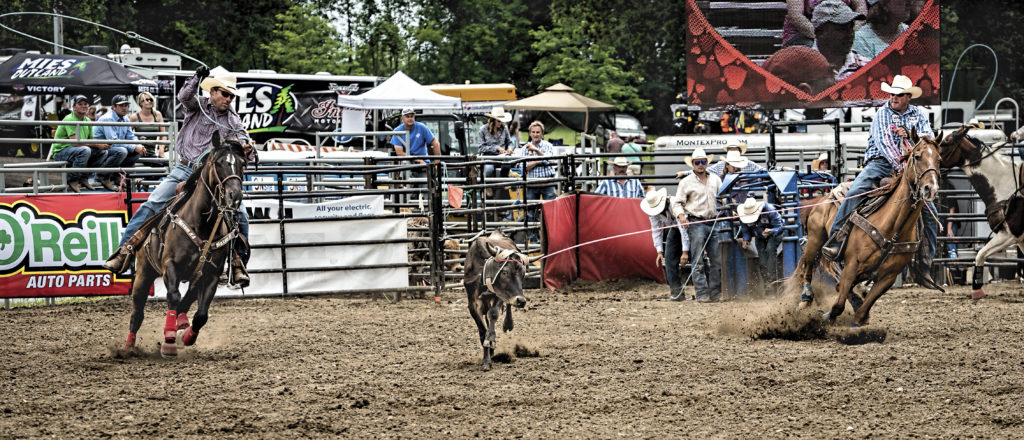
Team roping is the only rodeo event where men and women compete equally together in professionally sanctioned competition, in both single-gender or mixed-gender teams. Team roping is similar to calf roping, but with a fully grown steer. After the steer is given a head start, a pair of riders (a header and a heeler) chase after it. The header usually leads the charge and ropes the steer using one of three legal catches – around both horns, around one horn and the head, or around the neck. Any other catch is considered illegal and the team is disqualified. After the header makes his catch, he “dallies” (wraps his rope around his saddle horn) and turns the steer to the left, exposing its hind legs to the heeler. If the header doesn’t change the direction of the steer before the heeler ropes the hind legs, a crossfire penalty is assessed and the run is disqualified. Once the steer is turned, the heeler attempts to rope both hind legs. If he catches only one foot, the team is assessed a five second penalty. After the heeler ropes the hind legs, he “dallies” and the header turns his or her horse to directly face the steer and heeler. Both horses back up slightly to stretch out the steer’s hind legs, immobilizing the animal. This is when the clock is stopped. If the header takes off too early, a ten second penalty is assessed.
Tie-Down Roping
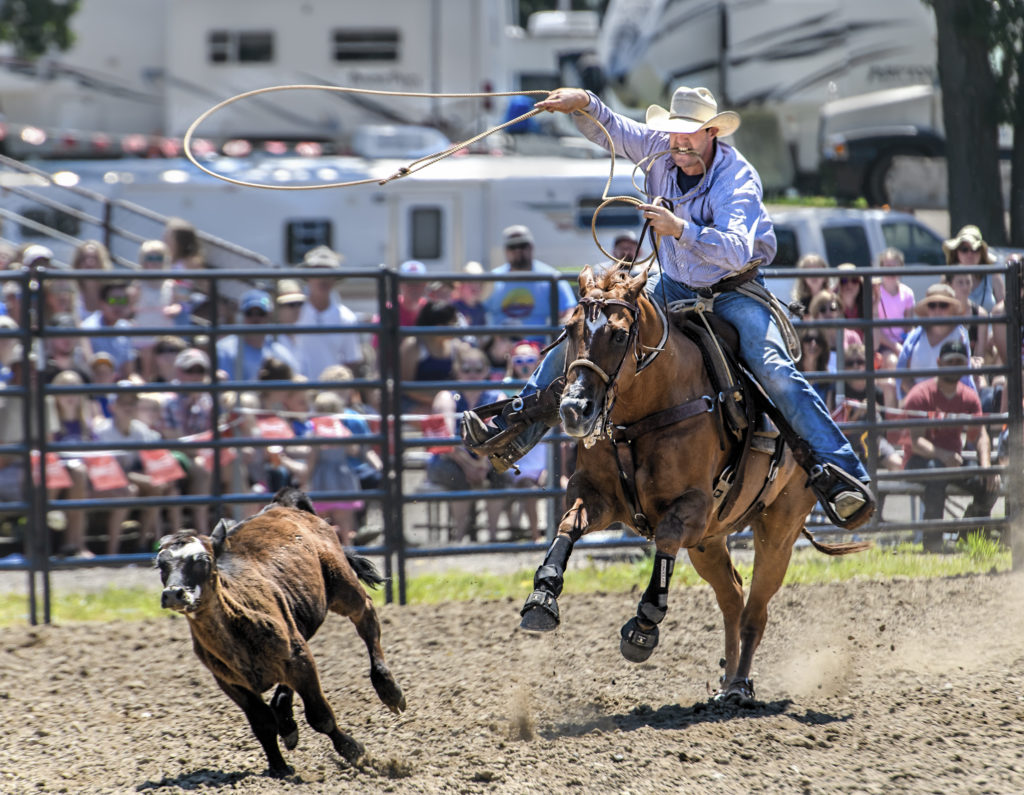
This event was born out of a ranch necessity for catching and restraining sick calves, but today it is a showcase of the teamwork between the cowboy and his horse. The calf is given a head start and the cowboy’s goal is to catch the calf and tie its legs as quickly as possible. To do this, the rider catches up to the calf and throws a loop of rope from a lariat around the calf’s neck. The calf must be stopped by the rope but cannot be thrown to the ground by the rope ~ doing so results in disqualification. If the calf falls, the roper loses seconds because he must get the calf back on its feet. After the calf is stopped, the rider dismounts from his horse, runs to the calf, picks it up and flips it onto its side (a maneuver called flanking). Then he ties any three of the calf’s legs together using a small rope known as a pigging string. Once the legs are tied, the cowboy throws up his hands to stop the timer. He then remounts his horse and moves the horse forward to relax the tension on the rope. The timer waits for six seconds, during which the calf must stay tied before an official time is recorded. If the calf kicks free, the roper receives no time.
As in other timed events, if the cowboy starts too early, a ten second penalty is added to his time.
Cowgirl’s Barrel Racing

For the barrel racing event, the arena is cleared and three barrels are set up at different marked locations in a triangular pattern. The riders then enter the arena at full speed, quickly rounding each barrel in a cloverleaf pattern and then exiting where they entered. The rider is allowed to choose either the right or left barrel as their first barrel but must complete the correct pattern, allowing for turn changes depending on whether they are on the right or left lead. The riders steer their horses as close as they can to the barrels trying to shave precious seconds off the clock. For each barrel they knock over, a five second penalty is assessed to their total time. Running past a barrel and off the pattern will result in a “no time” score and disqualification. There is a sixty second time limit to complete the course.
Scoring – Rough Stock/Judged Events
Scoring for the rough stock events is the same for all three of the events, although different criteria exist for judging the animals in each event.
To earn a qualified score, the cowboy, while using only one hand, must stay aboard a bucking horse or bull for eight seconds. If the rider touches the animal, himself or any of his equipment with his free hand, he is disqualified.
Once the buzzer sounds and there is no disqualification, the ride receives a score given by official judges. Scores are given to both the competitor and the animal.
Cowboys are judged on their control and technique (up to 50 points), and the horses are judged on their power, speed, tenacity, and agility (up to 50 points). A perfect score is 100, good scores range from the upper 70’s to the upper 80’s.
Scoring – Timed Events
As the name implies, the timed events use stopwatches to track the times for each event, and the fastest time wins. All the timed events, except barrel racing, use a barrier (which is a rope with a flag attached and strung across the roping box). This makes the event more challenging as the barrier prevents the competitor from getting too much of a head start on the livestock.
Breaking the barrier prematurely results in a ten second penalty in each event.



